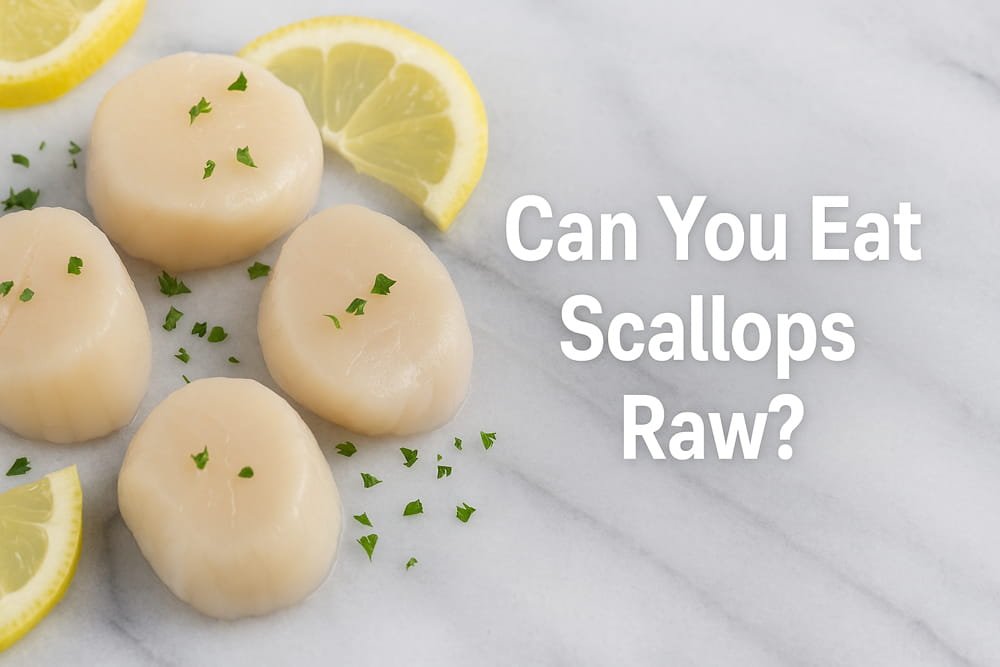Raw seafood has become a delicacy in many cultures, from Japanese sashimi to Italian crudo. Among the wide array of options, scallops stand out for their buttery texture and naturally sweet flavor. But with growing interest comes a pressing question: Can you eat scallops raw? This article explores everything you need to know about eating raw scallops safely—whether it’s about their taste, food safety risks, or how to choose the right type. Whether you’re a curious home cook or a seafood lover wanting to elevate your culinary experience, this guide will provide a comprehensive look at what it takes to enjoy scallops raw with confidence.
Contents
Can You Eat Scallops Raw?
Yes, scallops can be eaten raw—and in fact, they’re a delicacy in many cuisines around the world. In Japanese cuisine, raw scallops (hotate) are commonly served as part of sashimi or nigiri, prized for their tender texture and sweet, ocean-fresh flavor. Unlike some types of seafood that must be cooked to be safe, scallops are one of the few shellfish that can be consumed raw if properly handled. The key, however, lies in the freshness and sourcing of the scallops. Eating them raw is only advisable when they are sashimi-grade or sushi-grade and come from a trusted supplier.
Is It Safe to Eat Raw Scallops?
While it is possible to eat scallops raw, safety is a critical concern. Like any raw seafood, scallops can carry pathogens such as Vibrio bacteria or parasites if harvested or stored improperly. That’s why only scallops labeled as sushi-grade or sashimi-grade should ever be eaten raw. These designations indicate that the scallops have been handled and frozen according to strict food safety guidelines designed to kill parasites. The U.S. Food and Drug Administration (FDA) recommends freezing seafood at -4°F (-20°C) for at least seven days to ensure safety for raw consumption. Consumers should also avoid raw scallops that smell fishy, have a slimy texture, or are overly soft, as these are signs of spoilage. Ultimately, eating raw scallops can be safe—but only with careful sourcing and preparation.
How Do Raw Scallops Taste?
Raw scallops offer a unique culinary experience that sets them apart from their cooked counterparts. Their texture is delicate and slightly firm, often described as buttery or silky. Taste-wise, they carry a naturally sweet, clean, and briny flavor—something akin to the essence of the sea, without being overly fishy. When eaten raw, scallops allow for a fuller appreciation of their natural qualities, especially when served simply with a touch of citrus, olive oil, or soy sauce. For many, raw scallops are a highlight in sushi or crudo dishes because of this refined yet subtle flavor profile.
Best Types of Scallops for Eating Raw
Not all scallops are created equal when it comes to raw consumption. The two main varieties available on the market are sea scallops and bay scallops, and each differs in size, texture, and flavor.
Sea scallops are larger, meatier, and more commonly served raw in restaurants, especially in sashimi dishes. They have a firm yet tender texture, making them ideal for slicing thinly. Their naturally sweet flavor is more pronounced, which enhances their appeal when served raw.
Bay scallops, on the other hand, are smaller and softer. While they are sweeter than sea scallops, their size and delicate texture make them less suitable for raw preparations unless handled with extra care.
For best results, always choose dry scallops—those that haven’t been treated with preservatives or phosphates. These will have a cleaner taste and better texture when eaten raw. Look for scallops that are labeled as sushi-grade or sashimi-grade from trusted fishmongers or seafood suppliers.
How to Prepare Scallops for Raw Consumption
Proper preparation is essential to ensure both the safety and enjoyment of raw scallops. Follow these best practices:
- Source Quality Scallops: Purchase only sashimi-grade or sushi-grade scallops from a reputable source. These have been frozen under FDA-recommended conditions to kill parasites.
- Inspect Freshness: Fresh scallops should have a mildly sweet, oceanic smell—never fishy or sour. The flesh should be firm, slightly translucent, and free from sliminess.
- Keep Them Cold: Raw scallops must be kept refrigerated at all times and should be consumed as soon as possible after purchase. If needed, you can store them on crushed ice for short periods before serving.
- Clean and Trim: Rinse the scallops under cold water and pat them dry with paper towels. Trim away any tough muscle fibers from the side if present.
- Slice and Serve: Cut the scallops into thin slices or medallions for dishes like sashimi or crudo. Serve with simple accompaniments such as lemon juice, soy sauce, yuzu, olive oil, or fresh herbs to highlight their natural sweetness.
For deeper insights into seafood selection, see our guide on How to Choose Sashimi-Grade Seafood
FAQs About Eating Raw Scallops
Are scallops in sushi raw?
Yes, scallops used in sushi—commonly called hotate—are typically served raw, especially in Japanese cuisine. They are valued for their sweet flavor and silky texture.
Can you get sick from eating raw scallops?
If not properly sourced or stored, raw scallops can carry harmful bacteria like Vibrio, leading to foodborne illness. Always buy sushi-grade scallops and consume them quickly.
What do raw scallops look like?
Raw scallops are slightly translucent with a creamy off-white color. They should appear moist but not slimy, and they should smell clean and fresh like the sea.
How long do raw scallops last in the fridge?
Raw scallops should ideally be consumed within 24 hours of purchase. If kept cold at or below 40°F (4°C), they may last up to 1–2 days, but always inspect them before eating.
Are bay scallops good for eating raw?
Bay scallops can be eaten raw, but their small size and softer texture make them more delicate and slightly more difficult to prepare safely. Sea scallops are generally preferred.
Conclusion
Eating scallops raw is not only possible but also a culinary delight when done correctly. Their naturally sweet flavor and smooth texture make them a popular choice for sashimi and crudo dishes. However, food safety must always come first. Choosing sashimi-grade scallops from reputable sources, storing them properly, and handling them with care are all essential steps in enjoying raw scallops safely.
For those new to raw seafood, starting with sea scallops—which are larger and easier to work with—is highly recommended. Understanding the differences between sea and bay scallops can also help you make more informed decisions when buying.
For a detailed comparison between the two, read our guide: Sea Scallops vs. Bay Scallops: What’s the Difference?



